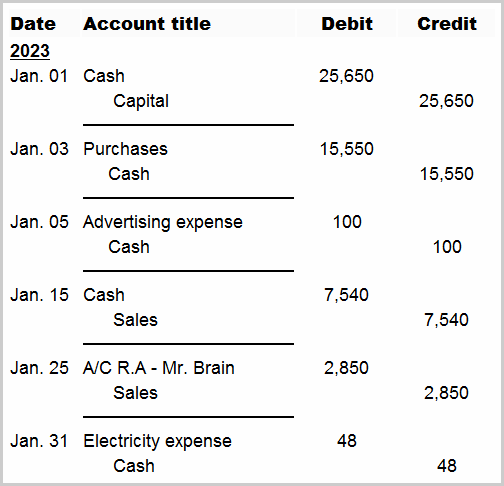Simple and compound journal entry
All transactions in a business are first recorded in the form of journal entries. A journal entry can be a simple or compound journal entry. This categorization is based on the number of accounts an entry consists of. Let’s explain and illustrate both types of accounting entries in this article.
Simple journal entry
A simple journal entry consists of only two account heads – one account is debited and the other credited. In other words, each of the debit and credit parts of the simple entry contains only one account.
A simple entry is the best reflection of the underlying transaction and the rules of debit and credit working behind the entry. Since no complexity is involved, simple journal entries are easy to understand and maintain by students, bookkeepers, and accountants, even with little to average knowledge of bookkeeping and accounting.
The frequently occurring daily transactions in a business, like sales, purchases, payments for utility bills, customers’ refunds, etc., are generally recorded through simple entries. Let’s take a few examples to illustrate the format and recording of a simple journal entry.
Examples of simple journal entries:
Mr. Danial started a trading business, namely Danial Traders, on January 1, 2023. It engaged in the following transactions during the first month of operations:
- Jan. 01: Mr. Danial invested $25,650 cash.
- Jan. 03: Purchased merchandise from Moon Bro. for $15,550 cash.
- Jan. 05: Paid $72 cash to FM-92 Radio and $28 to Local News Paper for advertisement.
- Jan. 15: Sold goods to Mr. Chopra for $7,540 cash
- Jan. 25: Sold goods to Mr. Brain amounting to $2,850 on credit.
- Jan. 31: Paid electricity bill for the month $48.
The simple journal entries to record the above transactions in the books of Danial Traders can be made as follows:

Compound journal entry
An accounting entry that consists of three or more account names is known as a compound journal entry. In other words, one of the debit or credit parts of a compound entry essentially contains two accounts. A compound journal entry, in fact, is a combination of two or more simple journal entries.
When an accounting event involves more than one journal entry, accountants and bookkeepers find it handy and convenient to merge them all to pass a single compound journal entry. This practice saves time by recording all debits and credits related to a single event in one place in the journal.
Examples of compound journal entry
Let’s take a couple of examples to illustrate how two or more simple entries can be merged to record only one compound journal entry.
Example 1
Albert Company gets a short-term loan of $50,000 from National Bank at 10% interest on January 1, 2022. The loan would be repaid along with interest on December 31, 2022.
To record the repayment of the loan along with interest, the company can pass either two separate simple journal entries (one for the principle amount and one for the interest) or a single compound journal entry.
If two separate simple entries are recorded:
(i). For repayment of principle:

(ii). For repayment of interest:

10% interest for one year:
= $50,000 x 0.1
= $5,000
If only one compound journal entry is recorded:

Example 2
On December 25, 2022, Abraham Inc. pays $9,900 and receives a discount of $100 to settle an account of $10,000 for a previous credit purchase.
This event also involves two accounting entries – one for the payment of cash for a previous credit purchase and the other for receiving the cash discount. It can be journalized by making two separate simple entries or one compound journal entry.
If two separate simple entries are recorded:
(i). For recording the cash payment to vendor:

(ii). For recording the cash discount received:

If only one compound journal entry is recorded:

The compound journal entries passed in the above two examples have only three account names. Some accounting entries are more complex and may contain dozens of account heads. An example of such entries is the journal entry for recording employees’ payroll.

Thanks..much helpful💯🙏
I always need latest news
It is very good thank you so much
Super